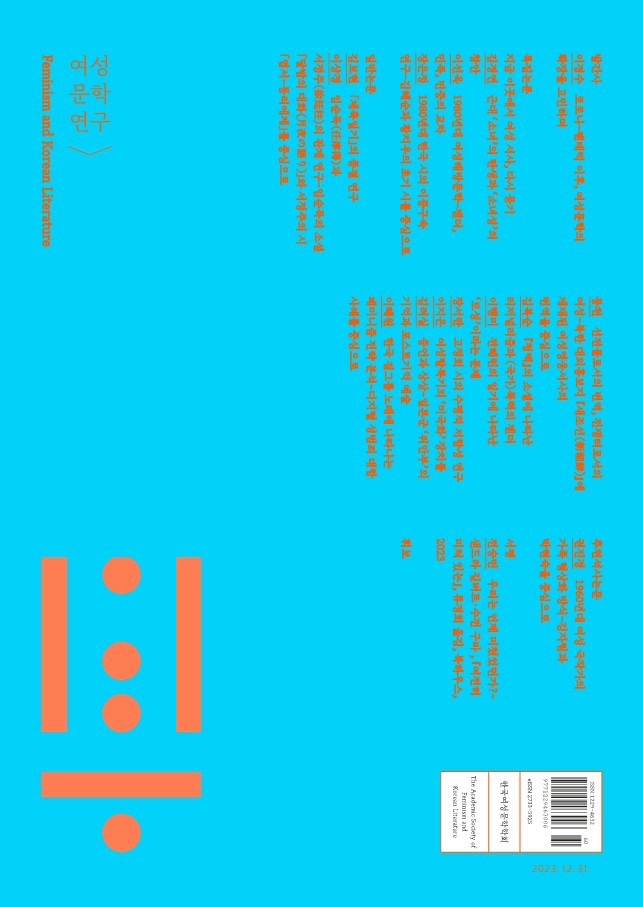- KOREAN
- P-ISSN1229-4632
- E-ISSN2733-5925
- KCI
 ISSN : 1229-4632
ISSN : 1229-4632
Article Contents
- 2024 (No.61)
- 2023 (No.58)
- 2022 (No.55)
- 2021 (No.52)
- 2020 (No.49)
- 2019 (No.46)
- 2018 (No.43)
- 2017 (No.40)
- 2016 (No.37)
- 2015 (No.34)
- 2014 (No.31)
- 2013 (No.29)
- 2012 (No.27)
- 2011 (No.25)
- 2010 (Vol.23)
- 2009 (Vol.21)
- 2008 (Vol.19)
- 2007 (No.17)
- 2006 (No.15)
- 2005 (No.13)
- 2004 (No.11)
- 2003 (No.9)
- 2002 (No.7)
- 2001 (No.5)
- 2000 (No.3)
- 1999 (No.1)
Body and the Metaphor of Illness and Food : Reading Kang, Kyung Ae's 『Ingan Munje(of Human Issues)』
Abstract
The body discourse can provide so many useful and salient points of reference in reading Kang, Kyung Ae's 『Ingan Munje(of Human Issues)』(1934), which this article analyses. According to this discourse, the ruling power tries to reduce human being into material body and make the body subordinate to its domination, while human being may pose some objection against the domination via such a body. The novel shows so clearly that the latter process can be represented in this real world. The subject who has properties and/or knowledge can treat the others as the bodies, who, in turn,respond to and challenge such treatment through presentation of the desires that stem from the bodies. Illness and food may constitute the main signals that unveil violent nature of social system and show solemn declaration of being humans who stand against such violence. Kang's novel has made a salient success in these aspects. It depicts secular desires of the female bodies so vividly, from which resisting power to challenge the dominant ruling powers and the ethics of the intercorporéité are firmly secured. The intercorporéité of the novel can make ever changing relationship between the characters, which is leaving apart from competition and conflict and moving toward sympathy and solidarity. It opens small but important possibility of feminized way of resist against de-humanizing powers.
- keywords
- 주체 중심주의, 상호육체성, 몸담론, 질병, 음식, 비체, subject, intercorporéité, illness and desease, food, body discourse, abject
Reference
강경애, ꡔ인간문제ꡕ 문학과지성사, 2006(최원식 책임편집).
강경애, 「파금」, ꡔ조선일보ꡕ, 1931. 1. 28.
강이수, 「식민지하 여성문제와 강경애의 ‘인간문제’—사회학자가 본 우리 소설」, ꡔ역사비평ꡕ 1993년 가을호, 335~348쪽.
김양선, ꡔ1930년대 소설과 근대성의 지형학ꡕ, 소명출판, 2003.
김진균․정근식 편, ꡔ근대주체와 식민지 규율권력ꡕ, 문화과학사, 1997.
김진아, 「시각과 쟁점: 여성의 몸, 어떻게 말할 것인가」, 한국여성연구소, ꡔ여성의 몸ꡕ, 창작과비평사, 2005, 20~44쪽.
박혜경, 「강경애의 작품에 나타난 여성인식의 문제」, ꡔ민족문학사 연구ꡕ 제23호, 민족문학사학회, 2003, 250~276쪽.
김경수, 「강경애 장편소설 재론」, 강경애 탄생 100주년 기념 문학제 심포지엄 발표문, 2006. 5. 12.
서영인, 「강경애 문학의 여성성」, 김인환 외, ꡔ강경애, 시대와 문학ꡕ, 랜덤하우스, 2006, 96~115쪽.
소영현, 「‘욕망’에서 ‘현실’까지, 주체화의 도정: 강경애의 ꡔ인간문제ꡕ 검토」, ꡔ한국근대문학연구ꡕ 제2권 제2호, 한국근대문학회, 2001, 31~51쪽.
엘리자베스 그로츠, 임옥희 역, ꡔ뫼비우스 띠로서의 몸ꡕ, 여이연, 2001.
이상경, ꡔ강경애 문학에서의 성과 계급ꡕ, 건국대 출판부, 1997.
이상경, 「여성문학의 두 얼굴」, ꡔ주변에서 글쓰기, 상처와 선택ꡕ, 민음사, 2006, 157~176쪽.
임옥희, ꡔ주디스 버틀러 읽기ꡕ, 도서출판 여이연, 2006.
조광제, ꡔ주름진 작은 몸들로 된 몸ꡕ, 철학과현실사, 2003.
태혜숙, 「한국의 식민지 근대체험과 여성공간」, ꡔ한국여성학ꡕ 제20권 1호, 한국여성학회, 2004, 33~56쪽.
홍기돈, 「식민지, 근대화 그리고 여성」, ꡔ강경애, 시대와 문학ꡕ, 김인환 외, 랜덤하우스, 2006, 71~95쪽.
하정일, 「강경애 문학의 탈식민성과 프로 문학」, ꡔ강경애, 시대와 문학ꡕ, 김인환 외, 랜덤하우스, 2006, 11~27쪽.
